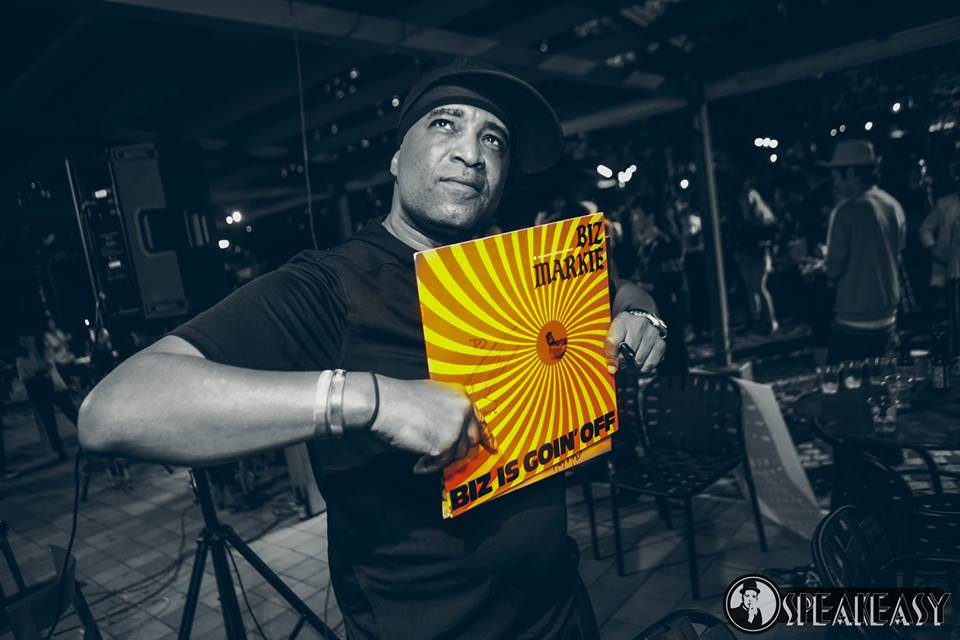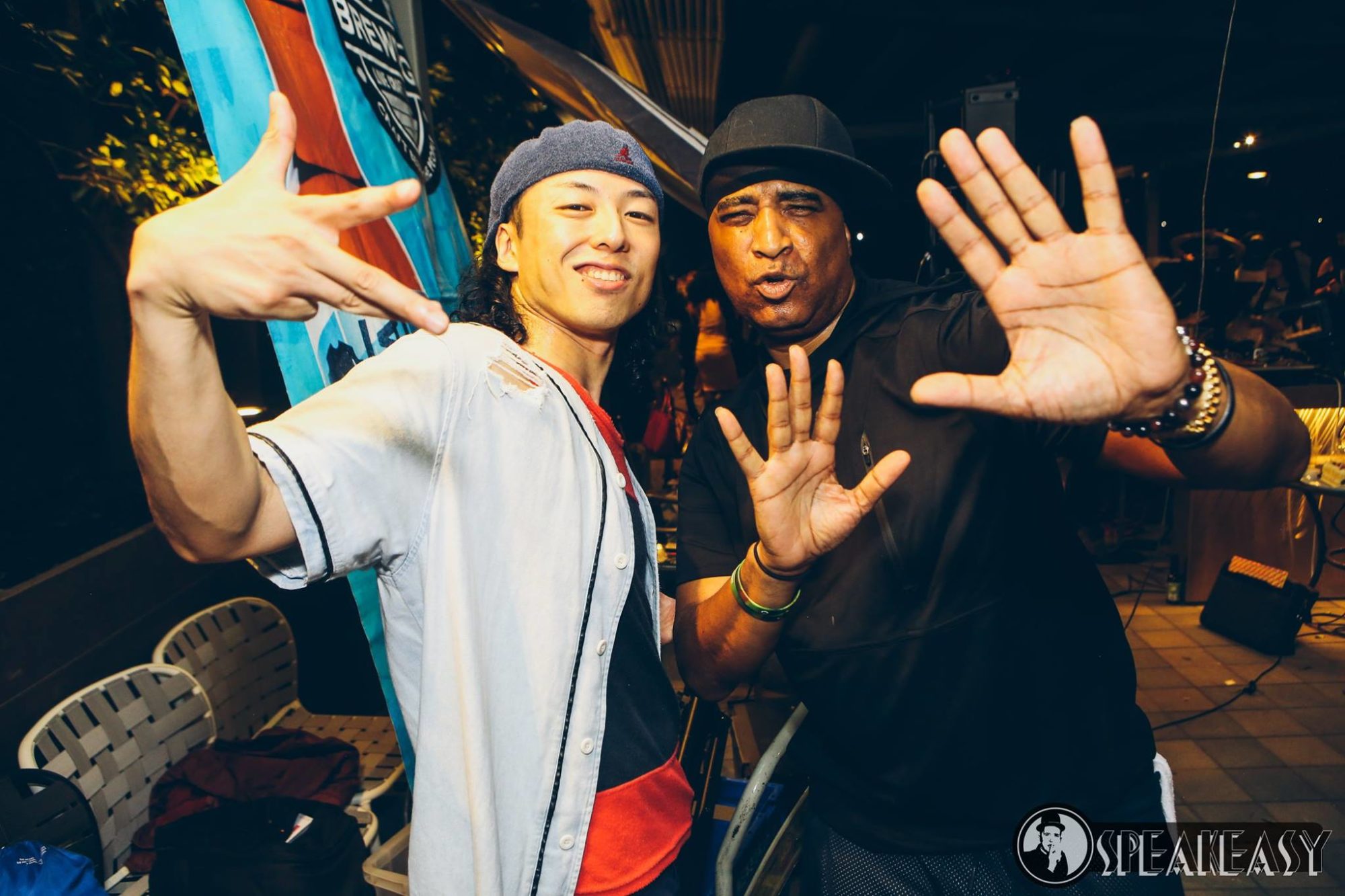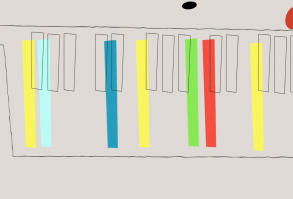
In October of last year, DJ and producer Marlon Williams, better known as Marley Marl, was here in Tokyo spinning at Speakeasy, a locally known mobile dance party that’s featured numerous pioneering DJ’s. Partygoers had him signing their vinyl copies of his classic singles like “Biz Is Goin’ Off” (1987). He was kicking it with loving fans, taking flicks, and the party’s promoter, Brooklyn Terry, brought him a sparkling cake to which the crowd sung him happy birthday. Marl was turning 56-years-old.
Right after his DJ set, I interviewed him in the conference room of a Shinagawa restaurant. He sat at a long table rubbing his hands together. They had just finished mixing, scratching, and blending hip-hop and his first love, house music. When asked to “tell a story” he turned his head right and slanted his eyebrows. “Let me get a beer,” he said. “Hold on.” Strutting back from the bar with beer in hand, he sat down and we got into his beginnings, rap’s fragmentation, Japan, and the re-appropriation of black music. Eventually, he said, “The funniest shit in the world happened.” It involved a DJ, white kids, and the word, “nigger.”
In the early 80’s in Queensbridge, New York City, Marl created some of hip-hop’s first sample-based rap music. Instead of recreating samples or using preset drum patterns, he was sequencing rhythms and was one of the first to source break beats from James Brown records. On early sampler machines like the Fairlight Computer Musical Instrument and the EMU Emulater, Marl cut and pasted musical notes the way DJ’s did it on turntables, but with the realization that he could simultaneously loop, layer, and mix snippets of any sound from any record.
Marl reinvented hip-hop and solidified its relevance, crafting hits like Roxanne Shante’s “Roxanne’s Revenge” (1984), “Eric B for President” (1986), “The Bridge” (1986), and “Mama Said Knock You Out” (1990). He was one of the co-founders of the almighty Juice Crew, rap’s original Voltron squad. Members like Big Daddy Kane, Kool G Rap, Biz Markie, Masta Ace, and Craig G fathered generations of spitters, reaching all the way to Kendrick Lamar, Wiz Khalifa, Earl Sweatshirt, and the late rapper and producer, Mac Miller. Every Juice Crew rapper used rhymes and flows for claws and teeth. “I had blood thirsty animals for the mic,” said Marl.
Along with radio DJ Mr. Magic (aka Sir Juice) and Tyrone “Fly Ty” Williams, Marl DJed Rap Attack on WBLS-FM. Originally launched by Mr. Magic in 1979, Attack was the first-ever major hip-hop radio show. Just as black DJ’s popularized “race records” or rhythm and blues post-World War II, Magic and Marl broadcasted rap, furthering the legacy of early DJ’s like Grandmaster Flowers and Larry Levan. Though Magic and Marl would rival DJ Red Alert on Kiss-FM, they were one of the preeminent shows for new experimental music. Attack was untethered black radio.
Mr Magic & Marley Marl Rap Attack, WBLS (1986)
Marl’s scratches were like grimy distorted guitar riffs, and before blending records became an official DJ standard, he was already making seamless transitions from one record to another. He was triggering movie and television clips and sound effects on his radio mixes. Marl made hip-hop a boundless clash of syncopated noise and sounds that stood outside the conventional confines of music. It was the audio translation of postmodernism. Nobody sounded like Marl.
He produced a banging symphony of that hardcore shit. It was the sound of the poor, black, angry, and, hunted. Low-income African-Americans neighborhoods were the backdrop for high arrest rates. Heavy police presence and the continuous scene of black kids getting beaten and handcuffed invoked fear and paranoia. African-Americans were eight times more likely to be incarcerated than whites. One in three black men in the U.S. were trapped in the criminal system. From 1985 to 1995, black women were the over all fastest-growing prison population. In New York City, even after crime had declined in the late 90’s, the police accelerated their arrests rates, especially in Harlem, East New York, and Marl’s area, Queensbridge, one of the largest public housing projects in America.
Tracks like the Marl-produced “Rikers Island” (1987) by DJ Polo & Kool G Rap embodied this cannibalistic environment that ate itself for survival. Marl’s soundscape is a straightjacket made of police sirens. The cut is a parable that could’ve been a convicted felon warning his younger sibling about getting locked up. Prison is the inverse of a panic room. “They have a nice warm welcome/ for new inmates/razors, and shanks/and sharp edged plates,” Kool G spits. “Rikers” addressed the inner cities under siege. The cut is especially prophetic since for-profit prisons were becoming the Starbucks of jails. Between 1980 and 2000, the number of jailed Americans quadrupled, from 502,000 to over 2 million.
Adding to the threat of incarceration, the 1980’s crack epidemic plagued low-income black families. The effect of crack on black fetal deaths and the amount of black children in foster care, doubled. The homicide rate among young black males, doubled. Having little influence on white America, drug addiction was viewed as a black disease not a national crisis. To quarantine the plague, local law enforcement swooped upon the presumably infected.
Given the present opioid epidemic and hip-hop’s new school rappers, Marl said that artists can only get record deals if “they talking about something fucked up to our community and bringing it down.” He said that the young rappers who are talking about psychoactive drugs is “killing our culture.” Just like the popularity of gangster rap saw the murders of numerous rappers and the vast incarceration African-Americans, the opioid epidemic has produced mumble rap. Private prisons, drug companies, and politicians profit from all of the above. For the few talented artists that are able to dodge the pitfalls and pressures to conform, its a way out of poverty. “If you don’t like mumble rappers, you don’t matter because these niggas made millions and millions of dollars off of other people loving them and you didn’t contribute to their success and they were still successful. You don’t matter. Shut the fuck up,” Marl said. In the same way that buying can’t exist without selling, drug addiction and drug dealing orbit around the product’s main supplier. Today, pharmaceutical companies and inadequate drug laws are blamed for the opioid epidemic. In the 80’s the CIA reportedly smuggled in massive amounts of cocaine into black American communities. The difference is that the opioid epidemic is a problem that’s also infecting white middle class America, now it’s a national crisis.
At the climax of the crack era, constantly hostile circumstances inspired rappers to write about their daily lives. They became the voices of their neighborhoods. “We had rap to ourselves. The world didn’t have it. It wasn’t for them. It was for us, where we was at,” Marl said. Prior to Sugarhill Gang’s hit “Rapper’s Delight” (1979) and Kurtis Blow’s “Christmas Rappin’” (late 1979), hip-hop music was barely considered a recorded music genre. Would-be fans had to gather at block parties to experience hip-hop. They had to be black, Latino, a kid from the neighborhood, or an outsider brought by an insider. Budding artists couldn’t upload their music, hoping to go viral. It emerged as influential art through its natural attraction. Like the telephone game, news of rap’s creation spread through the wire. Homemade cassette tapes of rap and live parties were the recorded happenings of the most innovative and disregarded.
Rap was considered degenerate music that could corrupt the youth of civil society. And yet it was “the longest running trend” that attracted white angst teenagers and others who recognized the cementing of a new popular sound. When Beastie Boys first appeared in the 80’s, they mocked the very music that made them legendary. Having readily admitted as much, they embraced their calling. “When I was doing my thing, they [Def Jam Records] wanted me to produce them [Beasties], but I wasn’t with that shit,” Marl said. “I wasn’t selling our culture out. I was trying to preserve it. I was never one to make other people look cool off of our shit.” Back then, aside from Blondie’s 1981 hit, “Rapture,” Beasties and 3rd Bass were the only credible white rap groups that had black co-signs. They helped introduce rap to the suburbs, which exponentially grew rap’s audience and annoyed parents that just didn’t understand.
Years later, rapper KRS-One put it best when he said, “Now we got white kids calling themselves, nigger” on “MC’s Act Like They Don’t Know” (1995). Marl said that the co-opting of rap is similar to the white takeover of rock n’ roll. In 1998, corporations consolidated hip-hop to cater to white America. “They took boom bap rap on the low,” he said. Marl even went so far as to say that “Alchemist infiltrated Queensbridge.” Well-established Los Angeles producer and rapper Alchemist is a white artist who’s closely associated with the Queensbridge-renowned rap group, Mobb Deep. Through Cypress Hill’s producer and DJ, Muggs, Alchemist met and started producing for Mobb in 1999. For over two decades, Alchemist has produced landmark joints with a lot of corner stone rappers. Still, from Marl’s perspective, Alchemist worked with Mobb just to get co-signed. “Now he ain’t fucking with nobody from the hood. No disrespect to Alchemist, but he infiltrated the hood and left the hood alone,” Marl said. Rather that’s true or not is debatable. The late 90’s and early 2000’s produced numerous white artists like El-P, Slug of Atmosphere, Eydea, and Aesop Rock whose revered music was as El-P said, “independent as fuck.” But in a broader sense, the majority of people that profit off of rap music aren’t black, nor are they from low-income black neighborhoods.
Because rap evolved out of African-American slaves who used verse to combat the mental terror of captivity, hip-hop is inherently a counter-culture. It expresses pain and it celebrates an imagined reality to free oneself from a life that he or she is living. Struggle and escapism are the elements of the culture that are universal to the human experience. Hip-hop’s all-inclusive appeal has enabled the world to be active participants within it. “It’s not like we just doing it for the hood anymore, Marl said. There’s too many genres of rap. There’s street rap, pop rap, mumble rap, boom bap. You can’t hold the mumble guys to the standards of boom bap because it’s two different things. It’s just like you can’t hold a Japanese rapper in Japan to the same standards that you would in America.”

In Japan, the black aesthetic is worshipped. Hip-hop has an overwhelming influence on Japanese pop culture. It’s everywhere. Generations of Japanese fans have learned English through rap. Tokyo is known for having one of the biggest graffiti scenes in the world. Kids spend hundreds of dollars at hair salons to get dreadlocks and afros. In Tokyo’s Harajuku district, shortly after fashion courtier Dapper Dan’s Gucci collection was released, sightings of kids rocking Dan’s clothes seemed instant. Amateur DJ’s and music connoisseurs maintain their record collection with the attention of pruning a Bonsai tree. They’re highly knowledgeable about hip-hop’s culture and history. They’re just as passionate about it as Americans, actually, perhaps even more so. Now we got Japanese rappers calling themselves, “nigger.”
Lesser-known and more visible Japanese rappers have used “nigger.” Either it’s their way of paying homage to the music or an attempt to embed themselves within it, however offensive, oblivious, or ignorant it may be to others. One of the latest instances is rising Japanese and Okinawan female rapper Awich, featured on rapper Kojoe’s “Boss Run Dem.” Awich mimics a dancehall rapper-like accent, seemingly to further lodge her use of the word “nigger.” In a 2016 interview with Lavatory Records, she said that she recorded two unreleased tracks with rapper Wise Intelligent of Poor Righteous Teachers. He’s a well-regarded artist whose rhetoric is comparable to Public Enemy or Dead Prez. Awich has lived in the U.S. and she is the mother of a child whose father was African-American. To some extent her use of “nigger” parallels white American female rapper V-Nasty’s. She’s from a predominantly black neighborhood in Oakland, California. She grew up saying the word “nigger” and she is the mother of black children. Unlike with Awich, “nigger” is plastered all over Nasty’s vocabulary like stickers in a bathroom dive bar. In 2011, she got a lot of push back, but the highly respected rapper, Mistah F.A.B., came to her defense.
Japanese rapper Kojoe, born in Japan, but raised in Queens, New York, raps in Japanese and English. On Raekwon’s 2011 track “Samurydas” (2011) he was featured along with Kurupt. African-American rapper Apani B is Kojoe’s ex-wife. Other Asian rappers like China Mac (who has since denounced use of the word) and $tupid Young have also used the word “nigger” just like black rappers use it in their rhymes. In the late 80’s and early 90’s, it was a hotly contested issue among older and younger African-Americans. Young black kids inverted its intended meaning as a form of brotherhood, without regard to their white peers. Older African-Americans that lived through segregation saw it as a precursor to the crushing of flesh and bone. It remains an extremely sensitive word that conjures American slavery and white guilt. But why should there be a double standard? In Japan, its normal to hear American rap in a dental office. Everyday young people hear “nigger” in their favorite rap songs. To non-black people who don’t have a personal history with that word, it may be more of a signifier than a racial slur. So is it ok for Japanese rappers to say nigger?
“Hell no. I don’t think it’s cool at all,” Marl said. He doesn’t think that anybody other than African-Americans should use “nigger,” but “we [black people] should even slow down because the funniest shit in the world happen. I live in the suburbs. I live in upstate New York and my next-door neighbors were having a party. Their daughter was graduating high school. I’m sitting on my property, but I can hear the music. It was cool. I was like ‘let me go outside, bring the Dutch and listen to the music cause I think they had a DJ. All of sudden he [the DJ] started playing the new rap.” Marl could hear the word “nigger” prominently on every record. “Now everybody is singing the words to the song and it’s a white family,” he said. “Now every time the song said ‘nigger’ I’m hearing all these white kids going word-for-word. I’m a black dude on the block and my other next-door neighbor is black. We’re the only two black people in about 20 houses. So I felt fucked up. But I was saying to myself, ‘Well it ain’t they fault. The motherfucker said it on the record. They just saying what the record saying. The genre is so big that it’s not just for us [black people] anymore. When it was just us back in the day and we said ‘nigger’ on the record and going word-for-word, I could understand because it’s not outside. Now it’s in the suburbs.”





1 comments On Marley Marl and the Social, Economic, and Political History Surrounding Hip-Hop’s Origin
Pingback: “The Fire This Time” featuring Brooklyn Terry, 7/7/2020 @10am (JST) – The Microscopic Giant ()